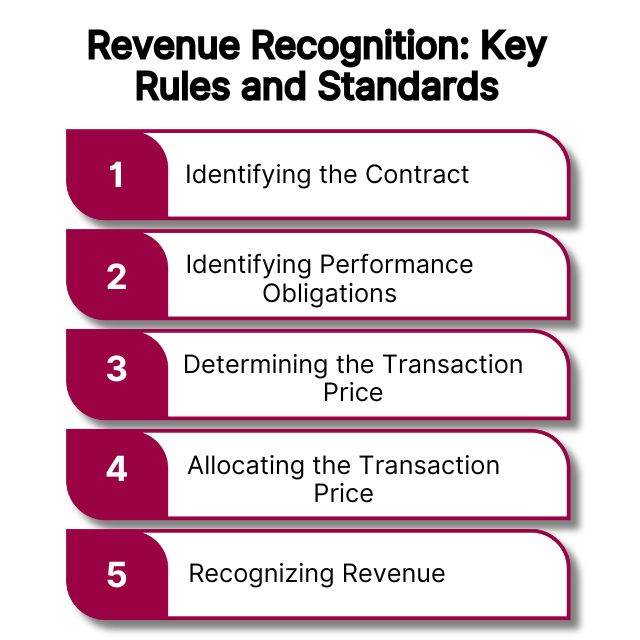Revenue recognition is a critical aspect of financial accounting that ensures a company’s financial statements accurately reflect its economic activities. Recognizing revenue from signed contracts requires a systematic approach, adhering to accounting standards and best practices to ensure accuracy, transparency, and compliance. With the introduction of the new revenue recognition standards, companies need to adapt and implement best practices for recognizing revenue from signed contracts effectively. This article explores the key principles, challenges, and best practices in revenue recognition from signed contracts.
Understanding Revenue Recognition
Revenue recognition refers to the process of recording revenue in a company’s financial statements when it is earned and realizable. It is a fundamental principle of accrual accounting, which requires revenue to be recognized when a transaction occurs, rather than when cash is received. Revenue recognition is governed by accounting standards, such as the International Financial Reporting Standards (IFRS) and the Generally Accepted Accounting Principles (GAAP). The standards ensure consistency, comparability, and transparency in financial reporting.
Read More: Challenges in Revenue Realization from Contracts
Key Principles of Revenue Recognition
To recognize revenue accurately from signed contracts, companies need to understand the key principles of revenue recognition:

- Identifying the Contract: A contract is an agreement between two or more parties that creates enforceable rights and obligations. For revenue recognition, a contract must meet specific criteria, including approval by all parties, identifiable rights, and payment terms.
- Identifying Performance Obligations: Performance obligations are the promises in a contract to transfer goods or services to the customer. Companies must identify each distinct performance obligation within a contract and determine how revenue will be allocated to each obligation.
- Determining the Transaction Price: The transaction price is the amount of consideration a company expects to receive in exchange for transferring goods or services. Companies must estimate the transaction price, considering factors such as variable consideration, discounts, and refunds.
- Allocating the Transaction Price: Once the transaction price is determined, it must be allocated to the performance obligations based on their relative standalone selling prices. This allocation ensures that revenue is recognized in proportion to the value of each obligation.
- Recognizing Revenue: Revenue is recognized when a performance obligation is satisfied, either over time or at a point in time. Companies must determine the appropriate method for recognizing revenue, depending on the nature of the goods or services provided.
Read More: Future of Contract Management and Revenue Realization
Challenges in Revenue Recognition from Signed Contracts
Recognizing revenue from signed contracts can be challenging due to the complexity of contracts, the diversity of industries, and the evolving nature of accounting standards. Some of the common challenges include:
- Complex Contractual Terms: Contracts may contain complex terms, such as multiple performance obligations, variable consideration, and contingencies, which require careful analysis and judgment in revenue recognition.
- Estimating Variable Consideration: Variable consideration includes elements such as discounts, rebates, and performance bonuses, which can impact the transaction price. Estimating variable consideration requires judgment and a robust estimation process.
- Changes in Contract Terms: Contract modifications, such as changes in scope, price, or terms, can affect revenue recognition. Companies must assess the impact of contract changes and adjust revenue recognition accordingly.
- Industry-Specific Practices: Different industries have unique revenue recognition practices, which require tailored approaches to ensure compliance with accounting standards.
- Compliance with Accounting Standards: Adhering to accounting standards, such as IFRS 15 and ASC 606, requires companies to implement new processes, systems, and controls to ensure accurate revenue recognition.
Generate Your Electronic Signature Instantly
Make your Electronic Signature in minutes using Legitt AI.
Try Making Your Signature
Best Practices for Revenue Recognition from Signed Contracts
To overcome the challenges in revenue recognition and ensure compliance with accounting standards, companies should adopt best practices for recognizing revenue from signed contracts. Here are some key best practices:
1. Implementing a Robust Revenue Recognition Process
A robust revenue recognition process is essential for ensuring accurate and consistent revenue recognition. Companies should establish a clear and systematic process for recognizing revenue, including:
- Standardizing Contract Evaluation: Develop standardized procedures for evaluating contracts, identifying performance obligations, and determining the transaction price.
- Implementing Internal Controls: Establish internal controls to ensure the accuracy and completeness of revenue recognition, including segregation of duties, approval workflows, and review processes.
- Automating Revenue Recognition: Utilize technology and software solutions to automate revenue recognition processes, reduce manual errors, and enhance efficiency.
2. Enhancing Contract Management
Effective contract management is crucial for accurate revenue recognition. Companies should focus on:
- Centralizing Contract Data: Maintain a centralized repository for storing and managing contract data, including key terms, performance obligations, and payment schedules.
- Tracking Contract Changes: Implement processes for tracking and documenting contract modifications, including changes in scope, price, and terms.
- Regularly Reviewing Contracts: Conduct regular reviews of contracts to identify any changes or updates that may impact revenue recognition.
3. Improving Estimation Processes
Accurate estimation of variable consideration and transaction prices is critical for revenue recognition. Companies should:
- Develop Estimation Models: Create estimation models for variable consideration, incorporating historical data, market trends, and expert judgment.
- Regularly Update Estimates: Continuously update estimates based on new information, changes in assumptions, and actual outcomes.
- Document Estimation Assumptions: Document the assumptions and methodologies used in estimating variable consideration to ensure transparency and auditability.
4. Enhancing Communication and Collaboration
Effective communication and collaboration between departments are essential for accurate revenue recognition. Companies should:
- Foster Cross-Functional Collaboration: Encourage collaboration between finance, sales, legal, and operations teams to ensure alignment on contract terms and revenue recognition policies.
- Provide Training and Education: Offer training and education programs to ensure employees understand the principles and practices of revenue recognition.
- Establish Clear Communication Channels: Create clear communication channels for sharing contract-related information and updates across departments.
5. Ensuring Compliance with Accounting Standards
Compliance with accounting standards is critical for accurate revenue recognition. Companies should:
- Stay Updated on Standards: Keep abreast of changes and updates to accounting standards, such as IFRS 15 and ASC 606, and adjust processes and policies accordingly.
- Conduct Regular Audits: Perform regular audits and reviews of revenue recognition processes to ensure compliance with accounting standards and identify areas for improvement.
- Seek Professional Guidance: Consult with accounting professionals and experts to ensure compliance with complex accounting standards and practices.
6. Leveraging Technology for Revenue Recognition
Technology plays a vital role in enhancing revenue recognition processes and ensuring accuracy and efficiency. Companies should:
- Implement Revenue Recognition Software: Utilize specialized software solutions for automating revenue recognition, tracking performance obligations, and managing contract data.
- Integrate Systems and Data: Integrate revenue recognition systems with other enterprise systems, such as ERP and CRM, to ensure seamless data flow and consistency.
- Utilize Data Analytics: Leverage data analytics tools to gain insights into revenue recognition patterns, identify trends, and optimize processes.
7. Customizing Approaches for Industry-Specific Practices
Different industries have unique revenue recognition practices that require tailored approaches. Companies should:
- Understand Industry-Specific Practices: Gain a deep understanding of industry-specific revenue recognition practices, challenges, and standards.
- Develop Industry-Specific Policies: Create customized revenue recognition policies and processes that align with industry practices and standards.
- Benchmark Against Industry Peers: Benchmark revenue recognition practices against industry peers to identify best practices and areas for improvement.
8. Managing Contractual Risks and Uncertainties
Contractual risks and uncertainties can impact revenue recognition. Companies should:
- Identify and Assess Risks: Identify potential risks and uncertainties in contracts, such as contingencies, penalties, and performance guarantees, and assess their impact on revenue recognition.
- Develop Risk Mitigation Strategies: Implement strategies for mitigating contractual risks, such as negotiating favorable terms, setting performance thresholds, and implementing contingency plans.
- Monitor and Report Risks: Continuously monitor and report risks and uncertainties to ensure timely identification and resolution of issues affecting revenue recognition.
Read More: How to Create an Electronic Signature for Free
Conclusion
Revenue recognition from signed contracts is a complex and critical aspect of financial accounting. By implementing best practices, companies can ensure accurate, transparent, and compliant revenue recognition. These best practices include establishing a robust revenue recognition process, enhancing contract management, improving estimation processes, fostering communication and collaboration, ensuring compliance with accounting standards, leveraging technology, customizing approaches for industry-specific practices, and managing contractual risks and uncertainties. By adopting these best practices, companies can achieve accurate financial reporting, enhance decision-making, and drive business success.
Did you find this article worthwhile? More engaging blogs and products about smart contracts on the blockchain, contract management software, and electronic signatures can be found in the Legitt AI. You may also contact Legitt to hire the best contract lifecycle management services and solutions, along with free contract templates.
FAQs on Revenue Recognition from Signed Contracts
What is the importance of revenue recognition in financial reporting?
Revenue recognition is crucial in financial reporting as it determines when and how much revenue is recorded in the financial statements. Accurate revenue recognition ensures that financial statements reflect the true economic activities of a company, providing stakeholders with reliable information for decision-making. It also ensures compliance with accounting standards, such as IFRS and GAAP, and helps maintain investor confidence and market credibility.
What are the key steps involved in recognizing revenue from signed contracts?
The key steps involved in recognizing revenue from signed contracts include:
1. Identifying the Contract: Ensure the contract meets the criteria for recognition, such as mutual approval, identifiable rights, and payment terms.
2. Identifying Performance Obligations: Determine the distinct goods or services promised in the contract.
3. Determining the Transaction Price: Estimate the amount of consideration expected in exchange for the goods or services.
4. Allocating the Transaction Price: Allocate the transaction price to each performance obligation based on their relative standalone selling prices.
5. Recognizing Revenue: Recognize revenue when each performance obligation is satisfied, either over time or at a point in time.
How do accounting standards like IFRS 15 and ASC 606 impact revenue recognition?
IFRS 15 and ASC 606 provide a comprehensive framework for revenue recognition, standardizing the principles across industries and jurisdictions. They emphasize a five-step model for recognizing revenue and require companies to disclose more detailed information about revenue sources, performance obligations, and contract balances. These standards aim to improve comparability, consistency, and transparency in financial reporting by eliminating industry-specific practices and promoting a principles-based approach.
What are performance obligations, and why are they important in revenue recognition?
Performance obligations are the distinct goods or services promised in a contract with a customer. They are crucial in revenue recognition because they determine how revenue is allocated and recognized. By identifying performance obligations, companies can ensure that revenue is recognized accurately and proportionately to the value delivered to the customer. This helps provide a clear picture of a company’s financial performance and contractual commitments.
How can companies estimate variable consideration in revenue recognition?
To estimate variable consideration, companies can use one of two methods:
1. Expected Value Method: Calculate the probability-weighted amount of all possible outcomes, which is useful when there are a large number of contracts with similar characteristics.
2. Most Likely Amount Method: Use the single most likely amount in a range of possible outcomes, which is suitable when there are only two possible outcomes.
Companies should consider historical data, current conditions, and future expectations when estimating variable consideration. They must also update estimates regularly and apply constraints to avoid overstating revenue.
What are some common challenges in revenue recognition from signed contracts?
Some common challenges in revenue recognition include:
• Complex Contractual Terms: Dealing with contracts that have multiple performance obligations, variable consideration, and contingencies.
• Estimating Variable Consideration: Accurately estimating discounts, rebates, performance bonuses, and other variable elements.
• Changes in Contract Terms: Handling contract modifications and assessing their impact on revenue recognition.
• Compliance with Accounting Standards: Adhering to evolving accounting standards and ensuring accurate implementation.
• Industry-Specific Practices: Navigating unique industry practices and adapting revenue recognition processes accordingly.
How can technology help in improving revenue recognition processes?
Technology can significantly enhance revenue recognition processes by:
• Automating Revenue Recognition: Implementing software solutions to automate contract evaluation, performance obligation tracking, and revenue allocation, reducing manual errors and enhancing efficiency.
• Integrating Systems: Ensuring seamless data flow between revenue recognition systems and other enterprise systems, such as ERP and CRM, for consistent and accurate data.
• Leveraging Data Analytics: Using analytics tools to gain insights into revenue patterns, identify trends, and optimize revenue recognition processes.
• Enhancing Compliance: Utilizing technology to ensure compliance with accounting standards through automated audits and validations.
What role does contract management play in revenue recognition?
Contract management plays a vital role in revenue recognition by ensuring that contracts are accurately evaluated, monitored, and updated throughout their lifecycle. Effective contract management involves:
• Centralizing Contract Data: Maintaining a centralized repository for storing and managing contract information, facilitating easy access and review.
• Tracking Contract Changes: Implementing processes for tracking and documenting changes in contract terms, scope, and pricing.
• Regularly Reviewing Contracts: Conducting periodic reviews of contracts to identify any changes that may impact revenue recognition.
• Ensuring Compliance: Ensuring that contract terms align with accounting standards and revenue recognition policies.
How can companies manage risks and uncertainties in revenue recognition?
To manage risks and uncertainties in revenue recognition, companies should:
• Identify and Assess Risks: Identify potential risks in contracts, such as contingencies, penalties, and performance guarantees, and assess their impact on revenue recognition.
• Develop Risk Mitigation Strategies: Implement strategies for mitigating risks, such as negotiating favorable terms, setting performance thresholds, and implementing contingency plans.
• Monitor and Report Risks: Continuously monitor risks and uncertainties, report them to relevant stakeholders, and adjust revenue recognition processes accordingly.
• Conduct Regular Audits: Perform regular audits of revenue recognition processes to identify and address potential risks and improve accuracy.
What are the benefits of adopting best practices for revenue recognition from signed contracts?
Adopting best practices for revenue recognition offers several benefits, including:
• Accurate Financial Reporting: Ensuring that financial statements accurately reflect the company’s economic activities and contractual commitments.
• Enhanced Compliance: Meeting the requirements of accounting standards and avoiding regulatory penalties.
• Improved Decision-Making: Providing reliable financial information for informed decision-making by management and stakeholders.
• Increased Transparency: Enhancing transparency in financial reporting and building investor confidence.
• Optimized Processes: Streamlining revenue recognition processes, reducing errors, and improving efficiency and productivity.
